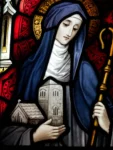Good morning.
St. Patrick’s Day in Whitewater will see an early evening shower with a high of 56. Sunrise is 7:01 AM and sunset 7:04 PM for 12h 02m 53s of daytime. The moon is a waxing gibbous with 99.2% its visible disk illuminated.
The Whitewater Unified School District’s Citizens Financial Advisory Committee meets at 6 PM.
On this day in 1776, the British Army evacuates Boston, ending the Siege of Boston, after George Washington and Henry Knox place artillery in positions overlooking the city.
Lisa M. Bitel, professor of history at the University of Southern California, writes St. Brigid, the compassionate, sensible female patron saint of Ireland, gets a lot less recognition than St. Patrick:
On March 17, the world celebrates the feast day of St. Patrick, a zealous British bishop of the fifth century who became famous for spreading Christianity in Ireland. Patrick is Ireland’s main patron saint.
But as a medieval historian, I suggest that we also pause to remember another of Ireland’s patron saints, the nurturing, compassionate St. Brigid.
This year, following a three-year campaign by a feminist organization, herstory.ie, the Irish government finally acknowledged Brigid’s importance by declaring a new national holiday on her feast day of Feb. 1. Until now, Ireland counted her among their official three patrons, along with St. Patrick and St. Columcille, or Columba, but gave workers a day off only on St. Patrick’s Day.
Unlike Patrick, who came from Britain, Brigid was born in Ireland, sometime around A.D. 450, the child of a slave and a king in the province of Leinster.
Unfortunately, Brigid left no historical record of her missionary work. Patrick wrote two letters that still exist: one a defense of his missionary career and the other a rebuke to a slave-raiding British king. All information about Brigid comes from biographies of saints written long after she lived. A churchman named Cogitosus was the first to write about Brigid, in about A.D. 650, or approximately 200 years after her birth.
Cogitosus recounted Brigid’s many purported miracles: As a girl, she gave away the household’s butter and bacon to hungry beggars and dogs, then miraculously replaced the food for her family. Later in life, she turned a wooden column into a living tree with one touch and hung her cloak on a sunbeam. After she founded her monastic community at Kildare and became its abbess, she also traveled, preached and was said to have cured Christians of serious debilities such as blindness and muteness, all in imitation of Christ. While many early female saints have miracles attributed to them, few of them actively proselytized.
….
Today, some people keep St. Brigid’s Day by weaving a special reed cross or visiting a holy well whose waters, blessed by Brigid, are believed to heal illness. The Brigidine Sisters of Kildare attend their ever-burning flame for Brigid, as nuns did in the Middle Ages. These seem like modest observances compared with the massive parades that flood the main streets of towns around the globe in annual celebration of Patrick.
This year on March 17, when you’re wearing the green and singing “Dirty Ol’ Town,” take a moment to whisper thanks to St. Brigid, the compassionate, sensible, native-born patron saint of Ireland, and ask if Ireland’s premier patron saint should be a woman.
Brazil Shows You Can Harvest Sugar Cane Without Polluting the Air:


